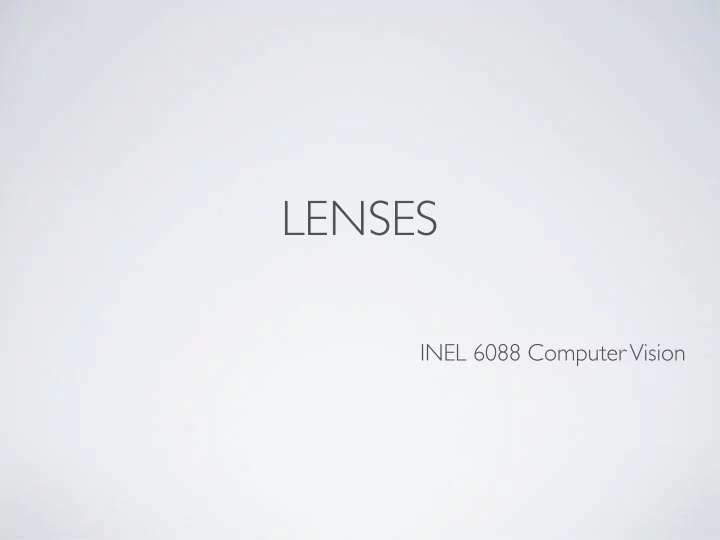

LENSES INEL 6088 Computer Vision
LENSES • The function of the lens is to collect more light • Image sensor size determines camera format • Lens should be chosen so that all features to be measured are covered in the image sensor, plus 10% for extra margin • Features must be at least 3 pixels across • If there are more than 100 features use a second camera 2
• Magnification = W camera /W FOV • FOV: Field of view = object area that is imaged by the lens onto the image sensor • W FOV =width of the FOV • W camera = width of the camera sensor • Working distance = distance from lens to object • Thin-lens approximation: lens thickness is neglected • Pinhole camera: no lens; images through a small hole 3
PINHOLE CAMERAS � Pinhole cameras work in practice • Abstract camera model - box with a small hole 4
Pinhole too big - many directions are averaged, blurring the image Pinhole too small- diffraction effects blur the image Generally, pinhole cameras are dark , because a very small set of rays from a particular point hits the screen. 5
THE REASON FOR LENSES 6
THE THIN Basic Properties: (1) Any ray entering the lens parallel to the axis goes through the focus on the other side; (2) any ray entering the lens from the LENS focus in one side emerges parallel to the axis on the other side Focal length: distance β α α between lens and β camera plane when the object is at infinity Magnification: Lens maker’s formula: m = z/z’ 7
(ignoring signs so -z ⇒ z and -y’ ⇒ y) z − f = P 0 P tan α = f P 0 tan β = P f = z 0 − f P 0 = z − f P f = f z 0 − f ( z − f )( z 0 − f ) = z 2 − z 0 f − zf + f 2 = f 2 zz 0 = z 0 f + zf f = 1 1 z + 1 z 0
SPHERICAL ABERRATION 9
LENS SYSTEMS 10
VIGNETTING 11
OTHER (POSSIBLY ANNOYING) PHENOMENA • Chromatic aberration � Light at different wavelengths follows different paths; hence, some wavelengths are defocussed � Machines: coat the lens � Humans: live with it • Scattering at the lens surface � Some light entering the lens system is reflected off each surface it encounters (Fresnel’s law gives details) � Machines: coat the lens, interior � Humans: live with it (various scattering phenomena are visible in the human eye) • Geometric phenomena (Barrel distortion, etc.) 12
Chromatic aberration
Light scattering (image flair)
Barrel distortion
RESOLUTION • Listed as resolving power in units of lines per inch/millimeter RP=1/2d lines/mm d = spacing between pixels in the image plane This equation neglects lens distortion – usually not an issue in M.V. 16
F/NUMBER • Cone angle of the rays that form an image • Determines • Brightness of image • Depth of field • Resolution of the lens • In MV the f/number can be taken as the ratio of the focal lens to the diameter of the aperture; large aperture -> small f/number 17
DEPTH OF FIELD • Larger aperture ↔ more light ↔ reduced depth of field • Depth of field: range of scene (object) distances with scene points that are in focus to an acceptable degree • Out of focus points are imaged to circles. If the diameter of the circle b is below the resolution of the sensor then defocusing is not significant 18
DEPTH OF FOCUS D b: maximum acceptable blur diameter d: lens’ diameter f: focal length z: scene distance (nominal plane of focus) Near plane distance Far plane distance 19
EXPOSURE E = Et • E : amount of light collected by the camera • E : image irradiance; intensity of light falling on the image plane • t : duration of exposure (shutter speed) 20
POLARIZATION • Some objects have certain features that are extremely bright, reflective or objects may be illuminated from an angle that produces intense reflection. • Polarize filters are a solution. 21
POLARIZATION • Normally light is linearly polarized: 22
POLARIZATION • A linear polarizer filter absorb E along some directions and transmit orthogonal to the direction of absorption. 23
POLARIZER AND TRANSMISSION AXIS (TA) 24
POLARIZERS 25
POLARIZERS 26
Recommend
More recommend